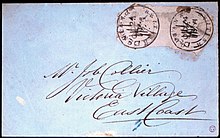Postage stamps and postal history of British Guiana

An 1856 British Guiana 1c magenta, regarded as the world's rarest stamp.

An 1850 British Guiana 2 cents pink "Cottonreel" pair on cover.
Provenance: Ferrary, King George V.

A 2 cent stamp of British Guiana,
issued in 1860.

An overprinted Mount Roraima commemorative stamp of 1898.

The 1954 72 cent stamp billed the Arapaima as the largest freshwater fish in the world.
A privately run packet service for mail existed in British Guiana in 1796, and continued for a number of years. Postage stamps of Britain were used in those days at Georgetown (Demerara) and Berbice. The first adhesive stamps produced by British Guiana were issued in 1850.
British Guiana is famous among philatelists for its early postage stamps, some of them considered to be among the rarest, most expensive stamps in the world. These include the unique British Guiana 1c magenta from 1856, which sold in 1980 for close to $1 million.
In June 2014 the 1856 British Guiana one-cent magenta stamp was sold at auction in New York, to an anonymous bidder, for $9.5m (£5.6m) at auction in New York, a world record.[1]
Contents
1 Cottonreels
2 1852 Issues
3 Commemorative stamps
4 Independence
5 See also
6 References and sources
7 Further reading
8 External links
Cottonreels
The London government established an inland postal system on 1 July 1850, but postage stamps had not yet been produced. The postmaster in Georgetown went to the local newspaper, the Royal Gazette, where he had them print imperforate stamps in the form of an outline circle, with "BRITISH GUIANA" inside the rim, and a denomination, from 2c to 12c, in the middle. The printing was in black, on different colors of paper depending on the denomination. These became known as the "Cottonreels" because of their circular shape, like the labels on spools of cotton,[2] and are quite rare.
1852 Issues
The first issue from London eventually came, in 1852. It was a very simple typeset design depicting a sailing ship and the colony's motto (misspelled) DAMUS PATIMUS QUE VICISSIM ("we give and expect in return"). These, also, are quite rare. Better stamps from London showed up in 1853, engraved and correctly inscribed, using PETIMUS instead.
The numbers were apparently insufficient, and in 1856 the postmaster had new 1c and 4c issues printed locally, crudely typeset and imitating the design of the London stamps, motto and all. These are among the rarest of all stamps. The British Guiana 1c magenta is considered to be the rarest, as only one copy is known to exist.
Another shipment of stamps showed up in 1860, but difficulties were not over yet: locally printed stamps were needed again in 1862 and 1882. After that, stamps were reliably available.
Commemorative stamps
In 1898 a pictorial commemorative was issued for Queen Victoria's Jubilee, depicting Mount Roraima and Kaieteur Falls, and another in 1931 commemorating the 100th anniversary of the colony's formation. Additional regular pictorial series, depicting local scenes and industries, came out in 1934, 1938, and 1954, as well as the usual omnibus issues of the Commonwealth.
A set of three stamps issued in 1961 commemorated self-government. In 1964 a set was issued commemorating the 1964 Summer Olympics held in Tokyo.
Independence
In 1966 the country achieved independence from the United Kingdom, and changed its name to Guyana. Later stamps were issued by Guyana.
See also
- Arthur D. Ferguson
- Postage stamps and postal history of Guyana
- Revenue stamps of British Guiana and Guyana
References and sources
- References
^ [1]
^ "Our First Postage Stamps: The 'Cottonreels'", National Trust of Guyana Archived 2011-07-21 at the Wayback Machine
- Sources
- W.A. Townsend and F.G. Howe, Postage Stamps and Postal History of British Guiana, London, Royal Philatelic Society (August 1970) .mw-parser-output cite.citation{font-style:inherit}.mw-parser-output .citation q{quotes:"""""""'""'"}.mw-parser-output .citation .cs1-lock-free a{background:url("//upload.wikimedia.org/wikipedia/commons/thumb/6/65/Lock-green.svg/9px-Lock-green.svg.png")no-repeat;background-position:right .1em center}.mw-parser-output .citation .cs1-lock-limited a,.mw-parser-output .citation .cs1-lock-registration a{background:url("//upload.wikimedia.org/wikipedia/commons/thumb/d/d6/Lock-gray-alt-2.svg/9px-Lock-gray-alt-2.svg.png")no-repeat;background-position:right .1em center}.mw-parser-output .citation .cs1-lock-subscription a{background:url("//upload.wikimedia.org/wikipedia/commons/thumb/a/aa/Lock-red-alt-2.svg/9px-Lock-red-alt-2.svg.png")no-repeat;background-position:right .1em center}.mw-parser-output .cs1-subscription,.mw-parser-output .cs1-registration{color:#555}.mw-parser-output .cs1-subscription span,.mw-parser-output .cs1-registration span{border-bottom:1px dotted;cursor:help}.mw-parser-output .cs1-ws-icon a{background:url("//upload.wikimedia.org/wikipedia/commons/thumb/4/4c/Wikisource-logo.svg/12px-Wikisource-logo.svg.png")no-repeat;background-position:right .1em center}.mw-parser-output code.cs1-code{color:inherit;background:inherit;border:inherit;padding:inherit}.mw-parser-output .cs1-hidden-error{display:none;font-size:100%}.mw-parser-output .cs1-visible-error{font-size:100%}.mw-parser-output .cs1-maint{display:none;color:#33aa33;margin-left:0.3em}.mw-parser-output .cs1-subscription,.mw-parser-output .cs1-registration,.mw-parser-output .cs1-format{font-size:95%}.mw-parser-output .cs1-kern-left,.mw-parser-output .cs1-kern-wl-left{padding-left:0.2em}.mw-parser-output .cs1-kern-right,.mw-parser-output .cs1-kern-wl-right{padding-right:0.2em}
ISBN 0-900631-01-5
Further reading
Proud, Ted. The Postal History of British Guiana. Proud-Bailey Co. Ltd., 2000.
ISBN 1-872465-26-9
- L. N. Williams, "British Guiana's Cottonreels", Encyclopedia of Rare and Famous Stamps, v.I, pp.13-23. David Feldman (1992)
External links
- The British Guiana Study Circle.
- The British West Indies Study Circle.
- The British Caribbean Philatelic Study Group.
- Guyana Philatelic Society
| Wikimedia Commons has media related to Stamps of British Guiana. |